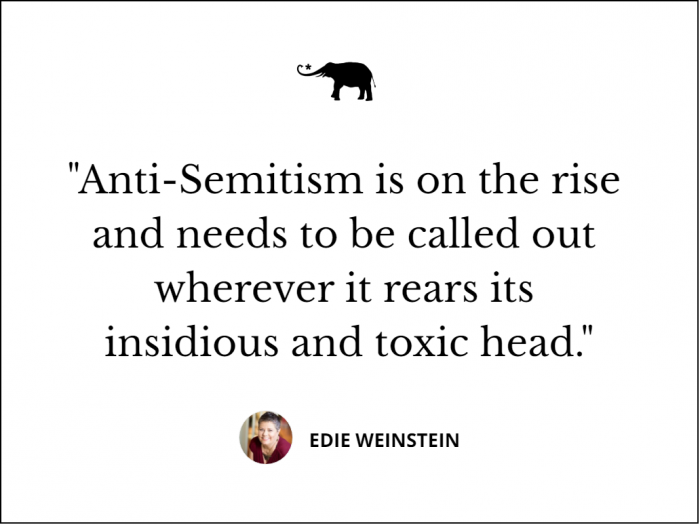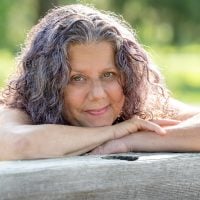Last night I attended a rally/vigil in my community of Doylestown, Pennsylvania that was hosted by a local community group called YouthFour Unity.
The purpose was to call out anti-Semitism that impacts people in massive ways (such as bombings and defacement of synagogues and Jewish cemeteries) and micro-aggressions such as hearing the statement, “You don’t look Jewish,” or thinking of Jews as penny pinchers or cheats.
The word “kike” is a common slur used against Jews that mirrors the “N word” to refer to people of color. Back when I was growing up, Jews were called “Christ killers” and were demonized as a result of the misreading of the Gospels after Jesus’ crucifixion. When I was a teenager, my best friend Barb (who was raised Catholic) and I listened to the soundtrack of Jesus Christ Superstar so many times that I’m surprised we didn’t wear the album out. It was my introduction to the story of the last days in the life of Jesus.
My upbringing was the polar opposite of hers. While I attended public school, she went to parochial school from 1st-12th grade and then graduated from LaSalle College (a Catholic school in Philadelphia). We met on the bench of a swim meet when we were on competitive teams and a bond was formed. I went to her house for her family’s holidays of Easter and Christmas and she came to my house for Passover and Chanukkah.
While we were listening to the song Gethsemene when Ted Neeley as Jesus was pouring his heart out, I thought to ask Barb if this portrayal was true to what she had been taught and she responded that it was. If the dialog was what Jesus was alleged to have said, it sounded like He and God were making an agreement, albeit, reluctantly. The gist of it was that although Jesus wasn’t too keen on dying in a horrific way, if God wanted Him to, He would do it.
“Why should I die?
Can you show me now that I would not be killed in vain?
Show me just a little of your omnipresent brain
Show me there’s a reason for your wanting me to die
You’re far too keen on ‘where’ and ‘how’ and not so hot on ‘why’
Alright, I’ll die!
Just watch me die!
See how I die!”
I reasoned, it made no sense the Jews would be blamed for his death. She said that was never discussed in her religion classes. I couldn’t wrap my head around the idea that people who worshipped Jesus as their Lord and Savior could hate members of his tribe. I often say that Jesus was a nice Jewish boy, born to a Jewish mother. He was called Rabbi. His initial disciples were Jewish. So, what gives? Christianity wasn’t the religion of Jesus, but rather the religion about Jesus. Although I can’t claim to speak for Him, I imagine he would be horrified with what violence and vileness people have caused and justified in His name.
When I saw the description of the event I attended, I knew I had to be there.
Pillars of the Jewish community will speak on their experiences with Antisemitism. We hope that by learning about firsthand experiences with Antisemitism, everyone will understand the dangers of Antisemitism, the resilience of the Jewish community, and how to be a Jewish ally.
Come support the speakers who are brave enough to share their story and use their knowledge to better the community.
Speaker List:
Rabbi Anna Boswell-Levy (she/her)
Lily Freeman (she/her)
Abagael Havkin (they/she)
Isabella Selekman (she/her)
Jerel Wohl (he/him)
While I was moved by the narrative of everyone who spoke, it was the teens who most brought goosebumps and what I call my “mama bear protectiveness” out. Horrifying that these young people had witnessed swastikas on lockers and bathroom walls, had endured harassment, had been called names, and had been asked why they didn’t have horns.
Rabbi Anna Boswell-Levy, from Kol Emet in Yardley, Pennsylvania, with voice cracking, spoke of her friend Jerry Rabinowitz, who was murdered at the Tree of Life Synagogue in Pittsburgh in 2018. She described him as a deeply caring person, who instead of hiding in fear, ran out to help others who had been shot by the radicalized white supremacist, whose name I won’t mention here—so as not to give him attention, but to focus on those whose precious lives he had taken simply because they were Jews who were praying.
As I listened, I pondered my own journey, relatively free of harassment. I grew up in a fairly diverse community, and while Jews were in the minority, there was a big enough Jewish community to fill two synagogues, Congregation Beth Torah (the one we attended), which was Conservative (not related to the political ideology, but a middle ground between Orthodox and Reform) and Temple Emmanuel, which was Reform.
I was never teased in school. The closest it came was the aforementioned, “Funny, you don’t look Jewish,” which was odd because with my dark, wavy hair and olive skin, I did have a stereotypical Eastern European appearance. I recently did an Ancestry.com test and it turns out that I am 100 percent Russian in origin. My younger sister, with her red hair and freckles, was often mistaken for Irish, which I always thought was humorous because she was born at St. Francis Hospital in Trenton, New Jersey a few days after St. Patrick’s Day. You know the inference when one child looks different that they are the milkman’s daughter or son? My sister actually was since our father worked as a milkman when we were each born.
The reality is, Jews have no particular “look” since people who practice Judaism are all over the world, with skin as pale as alabaster or as dark as a night sky.
My father would tell stories about the anti-Semitism that he faced growing up, being called a “dirty Jew.” He learned to fight to defend himself and became a Golden Gloves boxer in the Navy. That was also where he met a Southern sailor who looked at my father’s head, searching for the horns. My father explained that it was a misinterpretation of a biblical passage.
Because of his experiences, my father, first generation American born of Russian immigrant parents who came here to escape the pogrom in their native land, often seemed to be looking for an anti-Semite under every bed. He taught us to be proud of our heritage and in some ways to fear the beliefs of Christians that led to persecution of Jews for no other reason except that they were Jews. Even so, he and my mother allowed me to go to church with Christian friends, including my friend Barb who I mentioned earlier in the article. We were encouraged to be curious, but the idea of conversion was unthinkable.
When I got married, it was to a man who had been raised “run-of-the-mill, vanilla Protestant,” as he described it, and his family attended services at United Church of Christ. When we met, he was going to Quaker Meeting. Three years after we married, through no pressure coming from my family, he decided to convert to Judaism. He went through what we called his JIT (Jew in Training) classes in order to be a JBC (Jew by Choice). Several years later, he decided to become an Interfaith Minister and began to study at The New Seminary in New York City. It was founded by “modern Hassidic Rabbi” Joseph Gelberman as well as a priest, minister, imam, and yogi. It sounds like an opening line to a joke.
At that time, he was being treated for Hepatitis C and was unable to attend in person so he was a correspondence student. I assisted him with his studies and would read to him, type his papers, listen to the recordings, and watch the videos. I had no clue at the time what the bigger picture was for me since I had no intention of becoming ordained.
When he was lying in his hospital bed in the ICU, and his life support was disconnected, I heard what I call “The Voice” tell me to “call the seminary and finish what Michael started.” A few days after his funeral, I did just that and was told by the Dean, Diane Berke, that I could join the class on two conditions: the first that I was doing this for myself and not just Michael, and the other was that if I wanted to graduate with his class, I needed to do the first and second year’s work simultaneously or I could wait for the following year.
Workaholic, high achiever that I am, I chose the first option, and five months later, I walked down the aisle in June of 1999, at the Cathedral of St. John the Divine in Manhatten, to become ordained. My parents had flown up from Florida to be there with me. When I told my mother that I was enrolling, she asked if I was converting. I assured her that I wasn’t; I was expanding my beliefs. The motto of the seminary is, “Always in addition to, never instead of.” She was relieved and after my ordination, she started calling me her “Reverend Daughter,” an affectionate take off on the term “Reverend Mother,” I suppose. That is how a nice Jewish girl became an interfaith minister.
Anti-Semitism is on the rise and needs to be called out wherever it rears its insidious and toxic head.
If you see something, read something, or hear something, say something, even if your voice shakes and your heart pounds. We need to stand together.
I want to give a special shout out to the peacekeepers with their iridescent orange vests who stood guard around us at the event in case there were protestors. While someone was speaking, I heard some shouting in the street, but couldn’t discern what they were saying. I felt safe and protected. They are true mensches (a person of integrity and honor).











Read 6 comments and reply